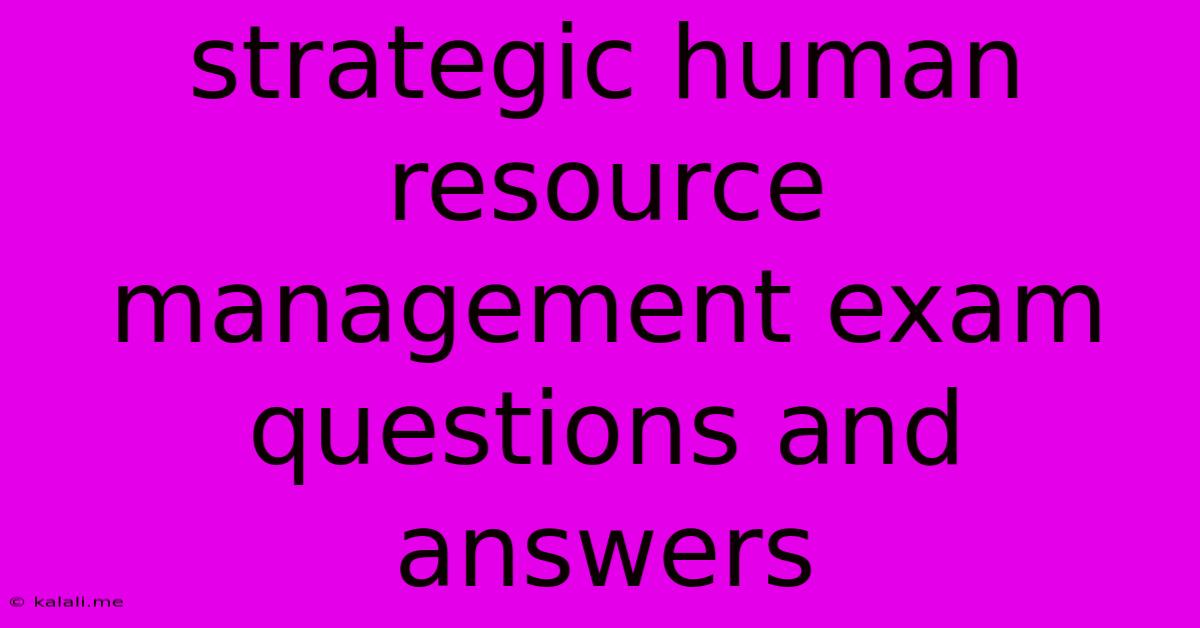Strategic Human Resource Management Exam Questions And Answers
Kalali
Jun 14, 2025 · 4 min read

Table of Contents
Strategic Human Resource Management Exam Questions and Answers
Meta Description: Ace your Strategic Human Resource Management exam with this comprehensive guide covering key concepts, sample questions, and detailed answers. Prepare for success with this in-depth resource on SHRM best practices.
Strategic Human Resource Management (SHRM) is no longer just about administrative tasks; it's a crucial function deeply intertwined with an organization's overall strategic goals. Understanding SHRM's role in achieving competitive advantage is key to success in any related exam. This article provides a range of exam-style questions and detailed answers to help you solidify your understanding of core SHRM principles.
Section 1: Strategic Alignment & HR Planning
Question 1: Explain the importance of aligning HR strategies with the overall business strategy of an organization. Provide examples of how misalignment can negatively impact performance.
Answer: Aligning HR strategies with the overall business strategy is crucial for organizational success. When HR functions are strategically aligned, they directly contribute to achieving the company's objectives. This means HR activities, such as recruitment, training, compensation, and performance management, are designed to support the business's strategic goals (e.g., growth, innovation, cost reduction). Misalignment, on the other hand, can lead to:
- Increased employee turnover: If HR practices don't support the company's needs, employees may feel undervalued or unsupported, leading to higher turnover.
- Inefficient resource allocation: HR initiatives may not address the company's true needs, resulting in wasted resources and missed opportunities.
- Lack of employee engagement: Employees may feel disconnected from the company's goals if HR practices don't reflect them, leading to lower morale and productivity.
- Failure to meet strategic objectives: Without alignment, HR can hinder rather than support the company's progress toward its goals.
Question 2: Describe the key steps involved in the human resource planning process.
Answer: Effective human resource planning involves several key steps:
- Forecasting future HR needs: Analyzing future business demands and determining the number and type of employees needed. This includes considering factors such as business growth, technological changes, and employee turnover.
- Analyzing the current workforce: Assessing the skills, experience, and competencies of the existing workforce to identify gaps and surpluses.
- Developing HR strategies: Creating strategies to address the identified gaps and surpluses, such as recruitment, training, succession planning, and workforce reduction strategies.
- Implementing and evaluating HR programs: Putting the strategies into action and monitoring their effectiveness. This involves tracking key metrics and making adjustments as needed.
- Regular review and updating: The HR plan should be a dynamic document that is regularly reviewed and updated to reflect changes in the business environment.
Section 2: Talent Acquisition & Management
Question 3: Discuss the benefits and drawbacks of different recruitment methods, such as internal recruitment and external recruitment.
Answer: Both internal and external recruitment have their advantages and disadvantages:
Internal Recruitment:
- Benefits: Cost-effective, faster process, improved employee morale, reduced risk, knowledge transfer.
- Drawbacks: Limited pool of candidates, potential for inbreeding, lack of fresh perspectives, may not fill skills gaps.
External Recruitment:
- Benefits: Access to a wider pool of talent, introduction of new ideas and skills, potential for improved diversity.
- Drawbacks: More expensive, longer recruitment process, higher risk of mis-hires, potential for integration challenges.
Question 4: Explain the importance of talent management in achieving organizational success.
Answer: Talent management is a crucial aspect of organizational success because it focuses on attracting, developing, and retaining high-performing employees. This involves creating a supportive work environment, providing opportunities for growth and development, offering competitive compensation and benefits, and fostering a culture of engagement and recognition. By investing in talent, organizations improve employee productivity, reduce turnover, enhance innovation, and gain a competitive edge.
Section 3: Performance Management & Compensation
Question 5: Compare and contrast different performance appraisal methods, such as 360-degree feedback and management by objectives (MBO).
Answer: Both 360-degree feedback and Management by Objectives (MBO) are performance appraisal methods, but they differ significantly in their approach:
- 360-degree feedback: involves gathering feedback from multiple sources, including superiors, peers, subordinates, and even customers. It provides a holistic view of an employee's performance.
- Management by Objectives (MBO): focuses on setting specific, measurable, achievable, relevant, and time-bound (SMART) goals. Employee performance is then evaluated based on their achievement of these goals.
Question 6: Discuss the key factors to consider when designing a competitive compensation and benefits package.
Answer: Designing a competitive compensation and benefits package requires careful consideration of several key factors:
- Internal equity: Fair pay relative to other employees within the organization.
- External equity: Competitive pay relative to other organizations in the same industry.
- Job analysis and evaluation: Accurately assessing the value of different jobs within the organization.
- Legal compliance: Adhering to all relevant labor laws and regulations.
- Employee needs and preferences: Considering employees' preferences regarding various benefits (health insurance, retirement plans, etc.).
- Organizational budget: Balancing the cost of the compensation and benefits package with the organization's financial constraints.
This article provides a foundation for understanding key concepts in Strategic Human Resource Management. Remember to further expand your knowledge through textbooks, case studies, and further research to comprehensively prepare for your exam.
Latest Posts
Latest Posts
-
Least Common Multiple Of 20 And 50
Jun 15, 2025
-
Best Coaching For Mppsc In Indore
Jun 15, 2025
-
Speed In A Given Direction Is Called
Jun 15, 2025
-
How Much To Send Sat Scores
Jun 15, 2025
-
What Does Area Under Velocity Time Graph Represent
Jun 15, 2025
Related Post
Thank you for visiting our website which covers about Strategic Human Resource Management Exam Questions And Answers . We hope the information provided has been useful to you. Feel free to contact us if you have any questions or need further assistance. See you next time and don't miss to bookmark.